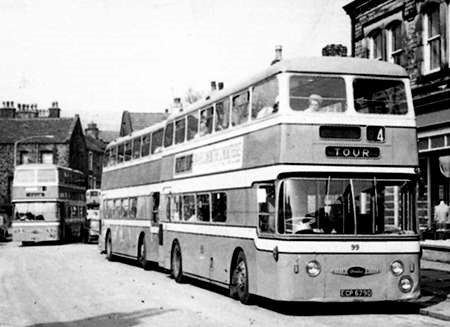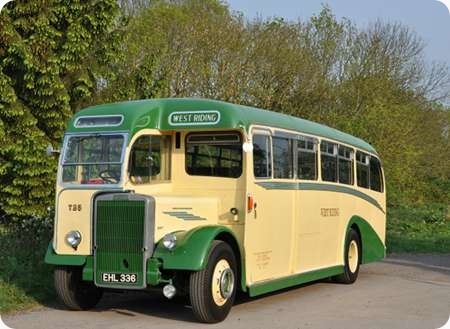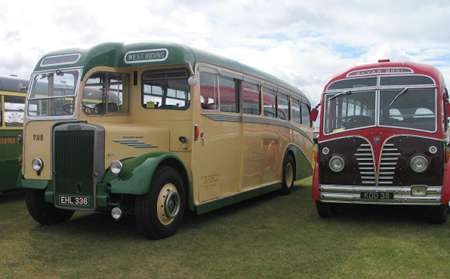West Riding – Bristol Lodekka – XNU 428 – 405
West Riding Automobile
1955
Bristol Lodekka LD6G
ECW H33/25RD
Around 1958, the Chief Engineer of West Riding, Ron Brooke, entered into collaboration with Guy, who then had an impeccable reputation for sound, robust engineering, in the design of a maximum capacity front entrance, low floor double decker, similar in concept to the then very new Leyland Atlantean, but with the engine mounted at the front. The basic ideas (together with the promise of substantial orders) came from Ron Brooke, but Guy then took up the design challenge with ill judged enthusiasm, incorporating a host of advanced features that ultimately contributed to the downfall of the resulting Wulfrunian model :- See this link
The Wulfrunian became the standard double deck purchase for West Riding from 1959 to 1965, by which time the profound deficiencies of the design had rendered it unsaleable to everyone else. When, in 1967, West Riding sold out to the nationalised Transport Holding Company (soon to become the National Bus Company) the new proprietors set about getting rid of the troublesome Wulfrunian fleet. A miscellany of double deckers from other NBC companies began appearing in West Riding green livery (the ex tramway red colour was abandoned, though NBC poppy red was soon to follow) and all the Wulfrunians went between 1968 and 1972, but only after donating their 6LX engines to new incoming Daimler Fleetlines. Seen in Leeds in April 1970 is No.405, XNU 428, ex Midland General 444, one of an entire batch of ten 1955 vintage Bristol LD6G with ECW H33/25RD bodies that passed to West Riding in June 1969. These ex Midland General Lodekkas did not last very long with their new owners, all ten being sold in July 1971, when XNU 428, by then 16 years old, went for scrap.
Photograph and Copy contributed by Roger Cox
31/07/17 – 07:28
Roger,
I think the location is Wakefield Bus Station. Service 61 was Wakefield to Bradford direct. Tong Cemetery would be a short working on that route, probably a late evening journey
John Blackburn
31/07/17 – 16:28
I am sure that you are right, John. I was relying on my unreliable high mileage memory, but I was, myself, a bit doubtful that West Riding would be running from Leeds to Tong Cemetery in Bradford. Thanks for the correction.
Roger Cox
31/07/17 – 16:29
Interesting link Roger about the Wulfrunian- thanks. The flaw in them must really have been the Gardner engine, oddly enough- too big, too heavy. Yes, it looks like the old Wakefield Bus Station with Union St behind. Remarkable that they repainted these buses so thoroughly when they only had two year’s life. That’s not a Wulfrunian behind as you may expect- but presumably a Fleetline? The taller drivers of these Lodekkas always looked so uncomfortable with the angled steering wheel and their legs splayed out on to the high floor. Were they?
Joe
01/08/17 – 07:18
I have driven some Lodekkas in my time, Joe, but, after escaping from Halifax Traffic Office in 1966, I went to Aldershot & District as a driver for some 18 months before returning to the admin side of the bus industry. The Lolines were superb machines, particularly the Mk.IIIs, and the driving position (which was not dissimilar to that of a car) soon felt quite normal. Turning the angled steering wheel in tight corners was easier than reaching across the "traditional" flat wheel of other makes (especially if one had something like a heavy PD3 to deal with). The Lolines were the best buses I have ever driven, and I’ve sampled quite a few types over the years.
Roger Cox
01/08/17 – 07:20
You were correct John regarding the late evening service. On Saturdays the 2150 from Wakefield bus station ran as far a Tong Cemetery returning from there to Wakefield at 22:36. The last through service to Bradford ran at 21:33. I managed to pick up a West Riding Time Table for 1970 somewhere along the rallies I attended so was able to check with that.
Brian Lunn
02/08/17 – 07:12
I could never understand why West Riding persevered with the Wulfrunian for so long after the shortcomings must have been fairly obvious with the first batch. Bury, LUT, West Wales, Accrington and County soon got rid of their examples yet West Riding was still ordering sizeable batches. Did they have some sort of contractual commitment to Guy? The failings must have been wider than the problem of combining a heavy front engine with the entrance as the two Accrington ones had rear entrances and a much reduced front overhang but they still didn’t last long. Wolverhampton 71 was an interesting one as this had a forward entrance and I understand drum brakes and seemed to have a more successful service life.
Philip Halstead
12/08/17 – 07:32
Just a guess, but I think the reason why West Riding kept taking repeat batches of Wulfrunians in fact right up to 1965 when it was pretty obvious from the first batch that the design was flawed was because they had to keep faith with Guy Motors because I was told the West Riding GM who had a massive input in its design & actually got West Riding to build it. I think the West Riding GM was called Ronald Brook and he touted the Wulfrunian design around various manufacturers, AEC being mentioned.
When West Riding decided to cut their losses & rid themselves of the Wulfrunians,the Halifax Lolines, old Bristol LDs, superior ex Bristol O.C FLFs and keeping lowbridge Guy Arab lVs longer plus new Fleetlines saved the day. All was not lost as a lot of valuable Gardner 6LX power units were salvaged & put in new Fleetline chassis.
Andrew Spriggs
Quick links to the - Comments Page - Contact Page - Home Page







